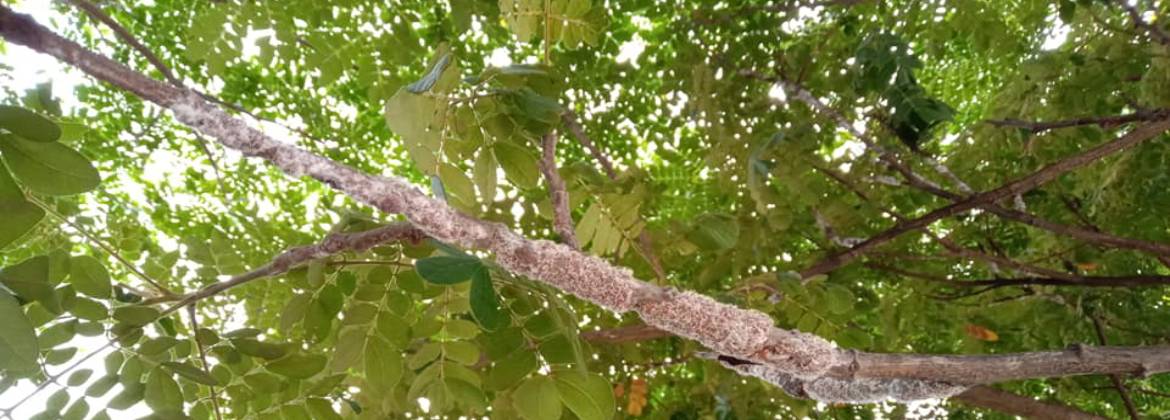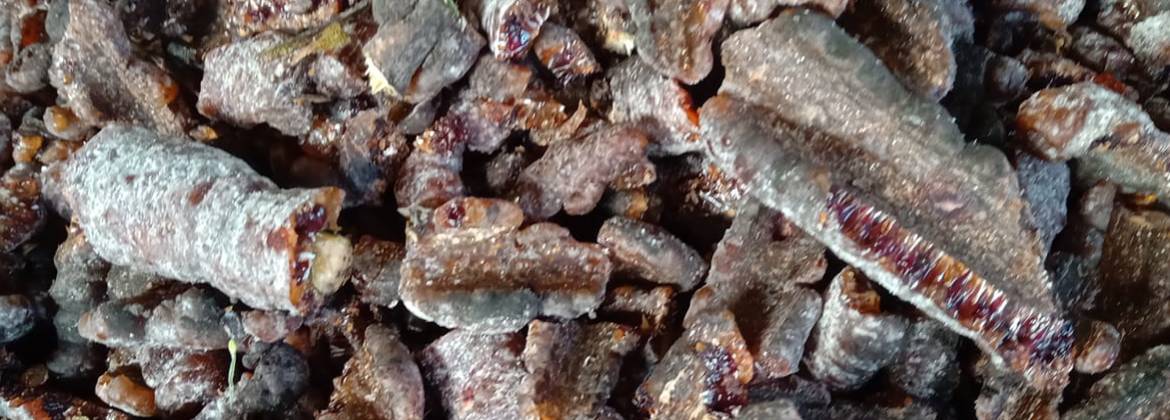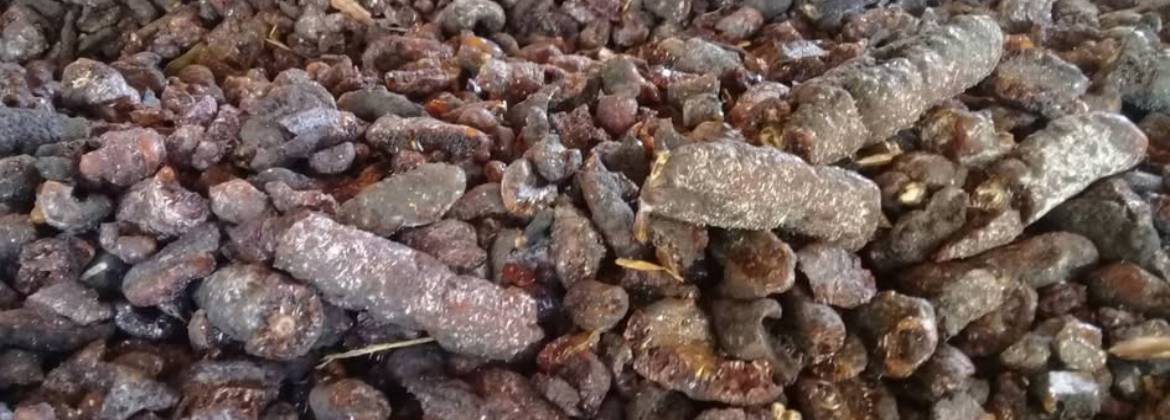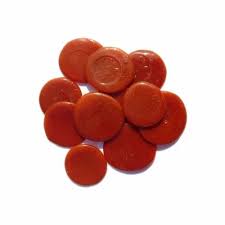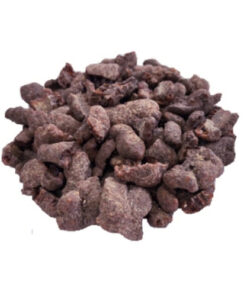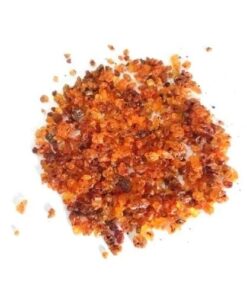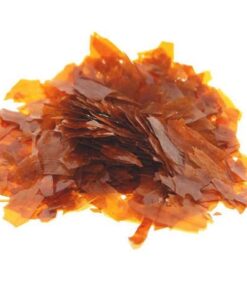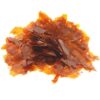Buttonlac
SPECIFICATION:
– Origin Vietnam
– Crop: 2023
– HS code: 1301.90.99
– Moisture content: Maximum of 2%
– Foreign matter: Maximum of 2%
– Packaging: 25 kg in plastic bag or carton box
– Container capacity: 20FCL: 12 tons
Sticklac is the resinous secretion of a kind of tiny insect known as Laccifer lacca. Stick Lac (Sticklac) is a resinous protective secretion of the lac insects on the hosting trees. Sticklac is collected as the minor forest produce and cultivated since time immemorial in Vietnam, and lac cultivation is an important source of income for livelihood of the forest and sub-forest dwellers of central and northern Vietnam. Sticklac still enjoys the monopoly of non-toxic, biodegradable, natural and safe resin and used for applications in pharmaceuticals, cosmetics and surface coatings for variety of uses in industries. Vietnam is the second largest producer, processor and exporter of the lac, having average production of 10, 000 tons for the last 5 years.
During processing of lac, various economically important by-products are obtained. The major component of lac is resin (65%) followed by two important by-products, viz. lac dye (1%) and lac wax (5–6%). The lac resin is processed into various value-added forms as per the need of the different industrial applications. Similarly, the dye and wax find its application in various sectors such as pharmaceutical, textile, etc.
 Most of Stick Lac (Sticklac) cultivators in Vietnam are tribal people. Their traditional cultivation method is to inoculate lac insects on to the hosting trees, which could be perennial trees or annual bushes. The cultivators must choose the right hosting trees scattered in the forest. Besides breeding lac insects, choosing the right hosting trees is important in their business.
Most of Stick Lac (Sticklac) cultivators in Vietnam are tribal people. Their traditional cultivation method is to inoculate lac insects on to the hosting trees, which could be perennial trees or annual bushes. The cultivators must choose the right hosting trees scattered in the forest. Besides breeding lac insects, choosing the right hosting trees is important in their business.
 After feeding lac insects on to the hosting trees, and leave it for swarming and come back to harvest it after five to six – months. The harvesting works will involve cutting down branches which bearing lac and tying broodlac to new hosting trees. The harvested host trees are left alone for one to two years so that new branches can come out.
After feeding lac insects on to the hosting trees, and leave it for swarming and come back to harvest it after five to six – months. The harvesting works will involve cutting down branches which bearing lac and tying broodlac to new hosting trees. The harvested host trees are left alone for one to two years so that new branches can come out.

Seedlac is formed into Buttons by the traditional hand made process. Hand made button shellac is produced by placing Seedlac into long narrow cloth tubes about 2″ in diameter and 30″ long and heating one end over a charcoal fire. The other end is attached to a windlass and is twisted gradually. Heat of the charcoal fire melts the lac which is forced through the cloth by pressure. The molten lac is scraped out manually onto sheets and the buttons left to harden. The process requires considerable manual skill and a lot of experience.
Buttonlac is preferred by restorers and those looking for a very protective shellac finish. It is superb for French polishing because of its hardness. The processing of buttonlac polymerizes it, resulting in a very tough material. Buttonlac’s toughness and moisture resistance.makes it the preferred choice for finishing floors and woodwork.
Specifications
BUTTON LAC SPECIFICATIONS
PARAMETERS |
UNITS |
BUTTON LAC No 1 |
BUTTON LAC No 2 |
BUTTON LAC No 3 |
Impurity |
% |
0.75 – 1.0 |
2.0-2.5 |
4.0-4.5 |
Colour Index |
Max. |
6.0-8.0 |
9.0-10.0 |
10.0-14.0 |
Acid Value |
mg KOH/g |
65.0 – 75.0 |
65.0 – 75.0 |
65.0 – 75.0 |
Ester Value |
mg KOH/g |
115.0 – 170.0 |
115.0 – 170.0 |
115.0 – 170.0 |
Saponification Value |
mg KOH/g |
180.0 – 245.0 |
180.0 – 245.0 |
180.0 – 245.0 |
Moisture |
% |
< 2.0 |
< 2.0 |
< 2.0 |
Rosin |
% |
0.0 |
0.0 |
0.0 |
Ash |
% |
< 0.3 |
< 0.3 |
< 0.3 |
Wax |
% |
< 5.5 |
< 5.5 |
< 5.5 |
Heavy metal – Lead (as Pb) |
ppm |
< 10.0 |
< 10.0 |
< 10.0 |
Heavy metal – Arsenic (as AS) |
ppm |
< 10.0 |
< 10.0 |
< 10.0 |
Flow |
mm |
> 40.0 |
> 40.0 |
> 40.0 |
Thermal curing time |
min |
> 25.0 |
> 25.0 |
> 25.0 |
Storage: Store in airtight containers in cool & dry place away from light & heat.
Caution: Avoid contact with eyes, inner ears, and sensitive areas.
MSDS
MATERIAL SAFETY DATA SHEET
(according to Regulation (EU) No. 1907/2006)
Product name: Sticklac Resin
Number: SLAC1223
1. IDENTIFICATION OF SUBSTANCE/PREPARATION & COMPANY.
Product name: Sticklac Resin
Manufacturer/Supplier: Vietnam Essential Oil., JSC
Add: Bai Dai Village, Tien Xuan Commune, Ha Noi City, Vietnam
Emergency telephone: +84 903561868
Emergency Contact: Mr. Peter Tron
2. COMPOSITION / INFORMATION ON INGREDIENTS.
Definition/Botanical Origin: Sticklac is the resinous secretion of a kind of tiny insect known as Laccifer lacca original Vietnam.
Composition: 100% pure & natural, raw material
CAS No: 9000-59-3
3. HAZARDS IDENTIFICATION:
This product is not hazardous. Not dangerous for the environment.
H304 May be fatal if swallowed and enters airways
H315 Causes skin irritation
H317 May cause an allergic skin reaction
H319 Causes serious eye irritation
4. FIRST-AID MEASURES:
Inhalation: Remove from exposure site to fresh air. Keep at rest. Obtain medical attention.
Eye contact: Rinse immediately with plenty of water for at least 15 mins. Contact a doctor if symptoms persist.
Skin contact: Remove contaminated clothes. Wash thoroughly with soap & water, flush with plenty of water. If irritation persists, seek medical advice.
Ingestion: Rinse mouth out with water. Seek medical advice immediately.
Other: When assessing action take Risk & Safety Phrases into account (Section 15)
5. FIRE FIGHTING MEASURES.
Extinguishing media Use CO2, Dry Powder or Foam type Extinguishers, spraying extinguishing media to base of flames. Do not use direct water jet on burning material.
Special measures: Avoid vapour inhalation. Keep away from sources of ignition. Do not smoke. Wear positive pressure self-contained breathing apparatus & protective clothing.
Extinguishing procedures: Closed containers may build up pressure when exposed to heat and should be cooled with water spray.
6. ACCIDENTAL RELEASE MEASURES.
Personal precautions: Avoid inhalation & direct contact with skin & eyes. Use individual protective equipment (safety glasses, waterproof-boots, suitable protective clothing) in case of major spillages.
Environment precautions: Keep away from drains, soils, surface & groundwaters.
Cleaning up methods Remove all potential ignition sources. Contain spilled material. Cover for spillages: with an inert or non-combustible inorganic absorbent material, sweep up and remove to an approved disposal container. Observe state, federal & local disposal regulations.
7. HANDLING & STORAGE.
Precautions in handling: Apply good manufacturing practice & industrial hygiene practices, ensuring proper ventilation. Observe good personal hygiene, and do not eat, drink or smoke whilst handling.
Storage conditions: Store in tightly closed original container, in a cool, dry & ventilated area away from heat sources & protected from light. Keep air contact to a minimum.
Fire protection: Keep away from ignition sources & naked flames. Take precautions to avoid static discharges in working area.
8. EXPOSURE CONTROLS/PERSONAL PROTECTION.
Respiratory protection: Avoid breathing product vapour. Apply local ventilation where possible.
Ventilation: Ensure good ventilation of working area.
Hand protection: Avoid all skin contact. Use chemically resistant gloves if required.
Eye protection: Use safety glasses.
Work/Hygiene practices: Wash hands with soap & water after handling.
9. PHYSICAL & CHEMICAL PROPERTIES.
Appearance: Dried resin
Colour: Orange-amber to brown resinous mass
Odour: Typical
Specific gravity at 20℃: not available
Refractive Index at 20℃: not available
Optical rotation at at 20℃: not available
Main components: Resin
Solubility: Insoluble in water./ Solubility in alcohol, solvents
10. STABILITY & REACTIVITY.
Reactivity: It presents no significant reactivity hazards, by itself or in contact with water. Avoid contact with strong acids, alkali or oxidising agents.
Decomposition: Liable to cause smoke & acrid fumes during combustion: carbon monoxide, carbon dioxide & other non-identified organic compounds may be formed.
11. TOXICOLOGICAL INFORMATION.
According to current information, not classed as hazardous to health in normal industrial use.
12. ECOLOGICAL INFORMATION.
Biodegradability: Data not available
Precautions: Prevent surface contamination of soil, ground & surface water.
13. DISPOSAL CONSIDERATIONS.
Avoid disposing to drainage systems and into the environment. Seek expert advice.
14. TRANSPORT REGULATIONS.
Shipping by road (ADR/RID): This product is not considered as dangerous goods
Shipping by air (IATA): This product is not considered as dangerous goods
Shipping by sea (IMDG): This product is not considered as dangerous goods
UN number: not regulated
UN proper shipping name: not regulated
Transportation hazard class: not regulated
Label: Sticklac Resin
15. REGULATORY INFORMATION. According to Directive 88/379/EEC
Hazards: Harmful
Symbols: n/a
Risk Phrases: Harmful if swallowed
Safety Phrases: If swallowed seek medical advice immediately and show the container / label
16. OTHER INFORMATION.
Cosmetics Directive – 7th Amendment – Not Restricted
Check maximum usage levels for skin care products.
PACKAGING:
In Jute bag 30-50kg
SHELF LIFE:
Best before of 24 months from the date of manufacturing.
Q.C. REQUIREMENTS.
In-line with general product specification. Always satisfy suitability for specific application.
The data provided in this material safety data sheet is meant to represent typical data/analysis for this product and is correct to the best of our knowledge. The data was obtained from current and reliable sources, but is supplied without warranty, expressed or implied, regarding its’ correctness or accuracy. It is the user’s responsibility to determine safe conditions for the use of this product, and to assume liability for loss, injury, damage or expense arising from improper use of this product. The information provided does not constitute a contract to supply to any specification, or for any given application, and buyers should seek to verify their requirements and product use.
Certificate of Analysis
CERTIFICATE OF ANALYSIS
Product name |
BUTTON LAC |
Cas No. |
9000-59-3 |
Manufacturing date |
12/2024 |
Expiry date |
12/2027 |
Origin |
Vietnam |
Batch No. |
BLAC1224 |
LAC BUTTON SPECIFICATIONS
PARAMETERS |
UNITS |
BUTTON LAC No 1 |
BUTTON LAC No 2 |
BUTTON LAC No 3 |
Impurity |
% |
0.75 – 1.0 |
2.0-2.5 |
4.0-4.5 |
Colour Index |
Max. |
6.0-8.0 |
9.0-10.0 |
10.0-14.0 |
Acid Value |
mg KOH/g |
65.0 – 75.0 |
65.0 – 75.0 |
65.0 – 75.0 |
Ester Value |
mg KOH/g |
115.0 – 170.0 |
115.0 – 170.0 |
115.0 – 170.0 |
Saponification Value |
mg KOH/g |
180.0 – 245.0 |
180.0 – 245.0 |
180.0 – 245.0 |
Moisture |
% |
< 2.0 |
< 2.0 |
< 2.0 |
Rosin |
% |
0.0 |
0.0 |
0.0 |
Ash |
% |
< 0.3 |
< 0.3 |
< 0.3 |
Wax |
% |
< 5.5 |
< 5.5 |
< 5.5 |
Heavy metal – Lead (as Pb) |
ppm |
< 10.0 |
< 10.0 |
< 10.0 |
Heavy metal – Arsenic (as AS) |
ppm |
< 10.0 |
< 10.0 |
< 10.0 |
Flow |
mm |
> 40.0 |
> 40.0 |
> 40.0 |
Thermal curing time |
min |
> 25.0 |
> 25.0 |
> 25.0 |


